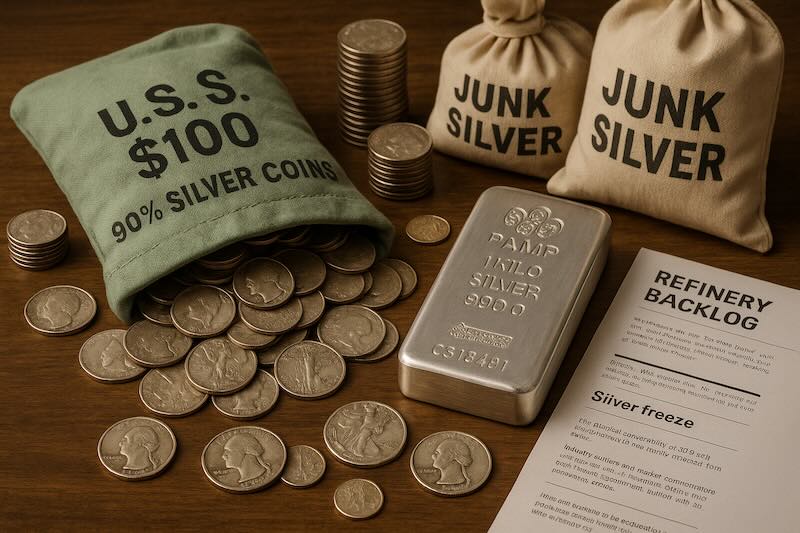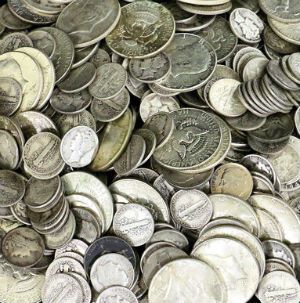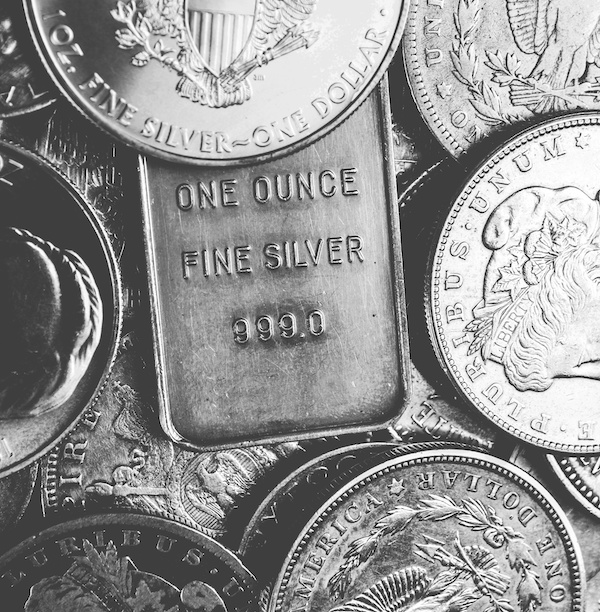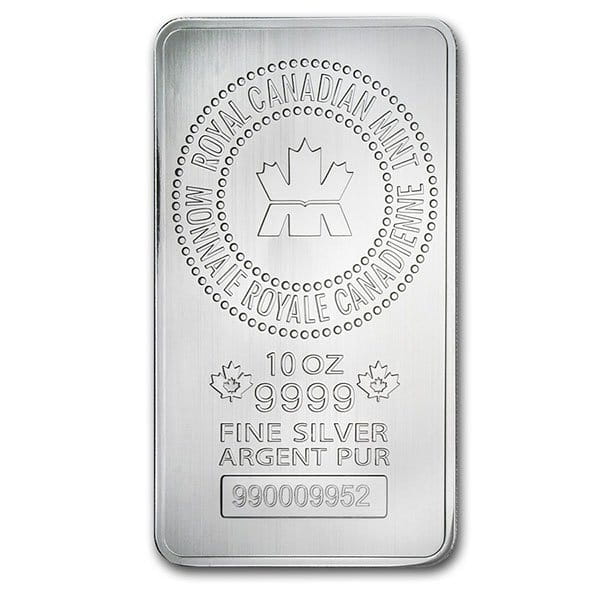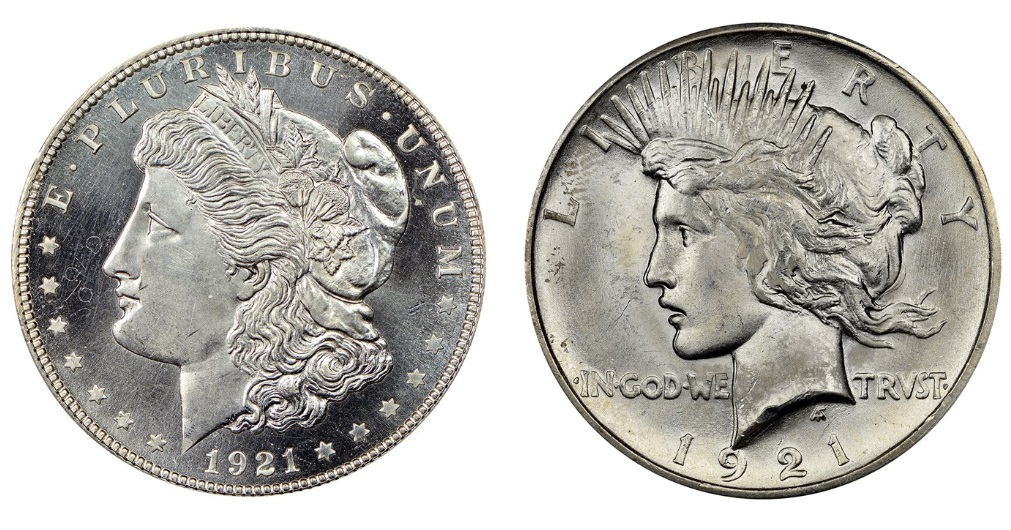What’s happening in the junk silver market: the refinery backlog and “silver freeze”
When spot silver rises quickly, people bring a lot of alloyed metal, including sterling flatware, junk silver lots, and jewelry, to refiners. Refiners must clean, assay and recast that lower-purity metal into lb/kg/Good-Delivery product acceptable on big wholesale markets.
With rising silver prices in 2025, refiners reported record intake levels, creating long processing queues. Simultaneously, the financing cost of holding physical silver, expressed in lease rates and other wholesale funding metrics, spiked, and in some cases, led to sharp increases in refiners’ carrying costs.
When financing and processing costs rise, some refiners temporarily limit intake or reprice scrap to avoid running a loss on processing. The practical result is twofold:
- Dealers who rely on refiners to convert junk silver into saleable product reduce their buyback activity or lower bids.
- The physical convertibility of 90% coin (what you can actually sell quickly, and for how much) diverges from the paper spot price.
Industry outlets and market commentators have documented this dynamic as a structural strain in the physical silver pipeline; some commentators call it a “silver freeze” because it creates a temporary illiquidity for scrap and 90% coin.
Retail Deals: How unusual are sub-melt and spot offers?
At the time of writing, multiple reputable dealers are advertising packaged 90% coin lots ($100 face bags of quarters or mixed face) at prices below the melt value.
| Dealer | % over / under spot | Notes |
|---|---|---|
| Monument Metals | -2.28% | Currently, $100 face bag of quarters priced $1.10 below spot per ounce |
| Bullion Exchanges | -2.18% | |
| Bullion Express | -1.83% |
Many of these offers meet the conditions for free shipping and reflect dealer strategies to rotate inventory, generate cash flow, or move packaged lots that are easier to re-sell.
Depressed Buybacks and Wide Spreads
Because refiners are throttling intake on scrap and 90% alloy, dealer buyback prices for ad-hoc walk-in silver lots have fallen relative to the paper spot; at the same time, offered retail prices on certain packaged inventory are being promoted at or below melt as dealers seek to rotate stock. This produces wider bid-ask spreads, and in some pockets, temporary inversions (i.e., packaged inventory sold near spot while ad-hoc buyback quotes are well below spot). Coin and bullion market reporting has documented multiple instances of dealers restricting purchases of scrap silver and narrowing the range of acceptable incoming material.
Why buy junk silver now? The possible arbitrage and the risks
Why an investor might consider buying:
- Price entry point: Under-melt or spot-priced packages reduce immediate cost per silver ounce, improving long-run upside if spot climbs and normal buyback premiums return.
- Fractional liquidity in normal markets: Junk silver (90% U.S. dimes, quarters, halves) is historically a convenient, fractional form for retail transactions and small sales—when buybacks function normally.
- Tactical play: If you believe the refinery backlog is temporary and that lease rates normalize, the spread between current buy price and later buyback quotes could create a medium-term arbitrage.
Risks and frictions to be explicit about:
- Sell-side illiquidity: Many refiners and wholesalers have limited the kinds of junk they will accept. You may face difficulty selling small, mixed lots at advertised spot levels until refiners process the backlog.
- Storage and insurance costs: Holding physical coins entails custody risk and, if insured or vaulted, recurring fees that affect total return.
- Tax and provenance considerations: Selling numismatic or circulated coins may trigger capital gains or be subject to collector premiums; consult a tax advisor if this matters to your position.
What professional forecasters are predicting for 2026
No single consensus number exists for silver in 2026; major banks, brokerages and independent analysts offer a range of scenarios depending on macro policy, industrial demand (notably photovoltaics), and how the physical market resolves its present backlogs. Some institutional commentary that has influenced market expectations includes:
- Coverage noting rapid bullion inflows and the macro drivers that initially pushed gold and silver higher in 2025. Analysts from major houses continue to publish scenarios that range from modest consolidation to materially higher levels if central-bank buying and supply disruptions persist.
Practical framing for 2026: treat bank forecasts as scenario inputs, not certainties. Reasonable scenario ranges commonly discussed among market strategists and commentators include:
- Base case: consolidation in a wider trading band (silver trading within a mid-range band, e.g., roughly $30–$60, depending on macro).
- Bull case: renewed policy dovishness, continued physical shortfalls, or major supply shocks could push silver prices materially higher (aggregated bullish calls sometimes point to $55–$100+ on episodic surges).
- Bear / consolidation case: stronger dollar, rising real yields, or a rapid increase in refinery throughput that eases physical constraints could bring silver back toward the low-to-mid $20s–$30s range.
Because bank and brokerage forecasts vary, avoid relying on a single house’s target: use scenario ranges and stress-test positions for liquidity needs.
Key Takeaways
- A significant, industry-level refining backlog and sharply higher physical-silver financing costs have disrupted how quickly 90% U.S. coinage (so-called “junk silver”) can be processed into tradeable 0.999 fine bullion. This has created a disconnect between paper spot prices and dealer buyback quotes that many in the industry are reporting as a “silver freeze.”)
- Several reputable dealers, including Monument Metals, Bullion Exchanges, and Bullion Express, are offering $100-face bags of 90% U.S. quarters and other formats for at or below melt.
- The trade-off: short-term illiquidity on the sell side. Many refiners and dealers have temporarily curtailed or restricted purchases of scrap and 90% silver, which can depress buyback prices and widen spreads. That makes “arbitrage” from current under-melt buys dependent on refinery throughput normalizing.
- Scenario planning (base / bull / bear) is more useful than a single price forecast; major trading houses and market commentators provide a wide range of 2026 silver scenarios. Investors should size positions according to liquidity needs, time horizon, and counterparty risk.
Bottom line
The present market offers rare tactical pricing on some packaged 90% coin lots, but those bargains are accompanied by material execution risk while refiners and wholesalers work through backlogs. If you are long-term, buying modestly sized, well-priced packaged lots with an understanding of the illiquidity risk can be a reasonable choice. If you need near-term liquidity, favor fungible government bullion with established bid-ask liquidity.
This article is educational and not individualized investment advice. consult a licensed financial and tax advisor for advice and decisions tailored to your circumstances. Always verify live dealer prices directly on their website before acting.
